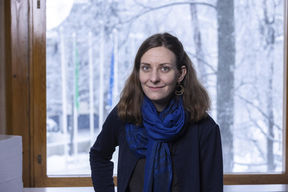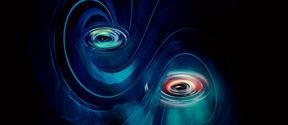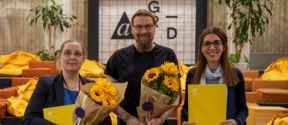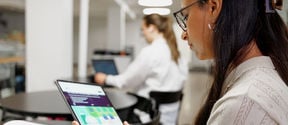Evading the uncertainty principle in quantum physics
New technique gets around 100-year-old rule of quantum physics for the first time

I continue to study microwave optomechanics which can allow us to uncover new fundamental physics. The research combines mechanical oscillators with optical resonators. Mechanical oscillators are stable; it takes a very long time before their motion decays. They are therefore good candidates for quantum memories in quantum computers. I am strongly motivated to carry on studying the mechanical oscillators in quantum states. One motivation to prepare such states, in the field of optomechanics, is to study the gravitational field around these massive objects in a quantum state.
Earlier in my career, I worked with very small objects. During my PhD, I worked with nanowires, which are extremely small and light objects, hundreds of nanometers across and tens of microns long. They oscillate a lot because they are very light.
Nowadays I’m working with drums, which are small superconducting membranes 10 to 20 microns across. They are much bigger and heavier objects—in fact, they are around 100,000 times heavier than the nanowires I used to work with. Their motion is therefore much smaller, but they can interact strongly with detecting systems thanks to their large surface. This is why it remains relatively easy to detect their motion.
My father is a researcher in geology and geophysics — he studies deformations of the Earth. I was probably somewhat influenced towards science while I was growing up. I also had really great physics teachers at university, including my PhD supervisor in Grenoble, France. I would say that the people who were around me led me to this path. Of course, I had a personal interest as well.
Initially, I was interested in physics in general. However, quantum physics was appealing to me, and my interest grew as a PhD student. My first quantum mechanics course was puzzling. In addition to raising a lot of questions, it’s also really a change of vision. One needs to be able to think differently.
From Grenoble, I came directly to Finland, where I started as postdoctoral researcher in 2018 and received Academy of Finland funding my researcher in 2021. In the beginning of 2022, I started as an Assistant Professor of Quantum Materials.
Receiving the Physics World Breakthrough of the Year award in 2021 has been the highest point of my career so far. With Professor Mika A. Sillanpää and the team, we were able to detect entanglement between two macroscopic drumheads. We were a small number of authors—only four—and all of us participated a lot.
The experiments were a trial-and-error type of process. It takes a lot of time to make samples, even a year or two to develop the fabrication process in the cleanroom. The measurements are carried out in a cryostat, and this is something I really like, in addition to doing the analysis. Measurements can take a couple of months, and we might do several experiments with the same sample.
The most common thing physicists talk about when popularizing quantum physics is Schrödinger’s cat. Instead of thinking that objects are in one state and that this state is always the same—meaning that the cat is either dead or alive before the box is open—one needs to admit that the cat is not in a definite state, because there is a thing called quantum superposition.
It is important to stay flexible in your understanding of the world. When studying quantum phenomena, we might need to reconsider our common presumptions in the face of scientific evidence. What we might have taken as true since we were born might have to be understood in a different manner.
I think it’s also important to be continuously surprised. Some researchers think there is no need for experiments to uncover emergent phenomena predicted by a well-established theory, but I find it important to measure what the theory has predicted to really discover new phenomena.
Finally, it’s important to be very patient and supportive with students when supervising them. Greatness might come out of any student in time.
I’m really interested in the applications of optomechanics. I’ll continue to work with mechanical oscillators, and I will try to do force measurements. One of my projects is to measure the Casimir forces that arise from quantum fluctuations. They are forces between metallic or superconducting surfaces facing each other. These forces are still a bit of a mystery in modern physics, even though they have been already measured quite accurately—but never using superconducting materials.
I plan to use our existing platform, the superconducting drum resonators. The samples we prepared in the team are well adapted to measuring Casimir forces between superconductors. Accurate measurements would help shed light on the subtle Casimir forces and might allow to resolve some controversies that have been ongoing in the Casimir community for years.
The research team is currently just me. I’m looking for people to work with! It’s very interesting to start from scratch and see an experiment grow. It is both hard work and rewarding.

New technique gets around 100-year-old rule of quantum physics for the first time



